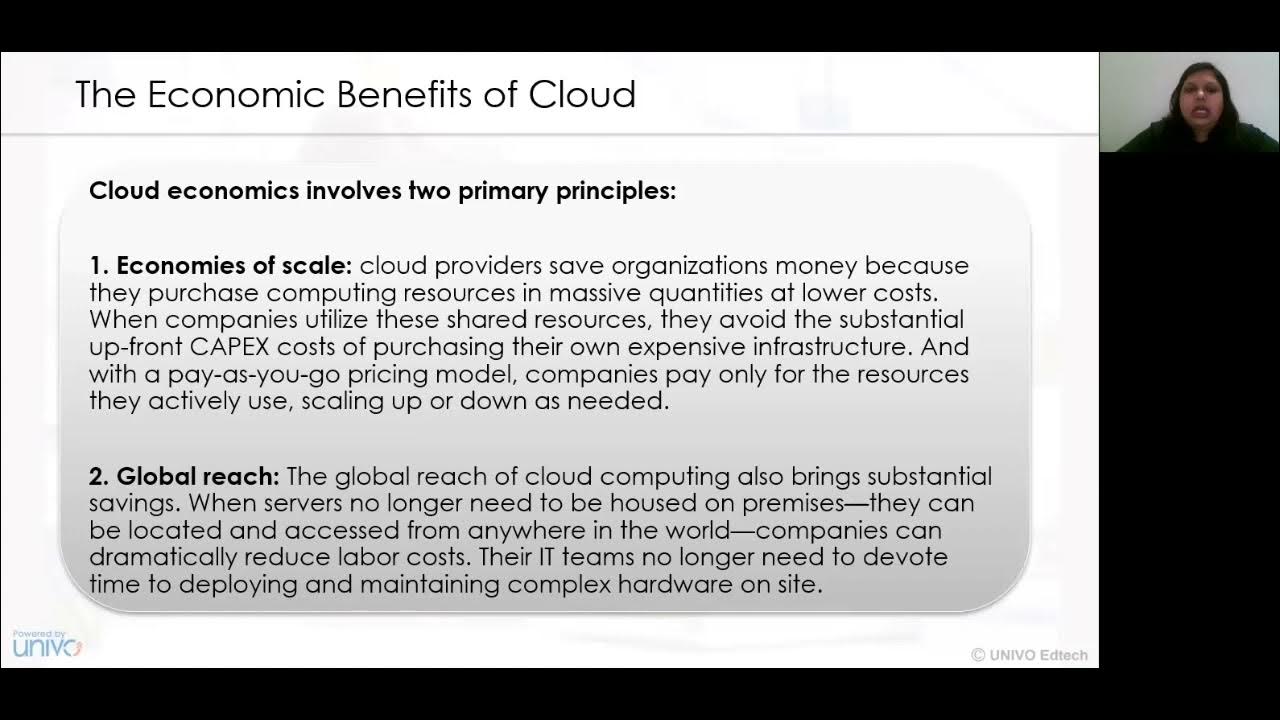Identify the Benefits of Cloud Computing - AZ-900 Certification Course
Summary
TLDRThis lesson explores the key benefits of cloud computing, including high availability, scalability, elasticity, agility, and disaster recovery. It explains how cloud services, hosted in global data centers, provide vast capacity on-demand, allowing businesses to scale and innovate quickly. The flexibility of cloud environments, with options for private or public connectivity, enables organizations to respond to changing demands with ease. Topics like auto-scaling, disaster recovery, and the consumption-based pricing model highlight the cloud's ability to deliver cost-effective, efficient solutions for dynamic business needs.
Takeaways
- 😀 Cloud computing provides benefits like high availability, scalability, elasticity, agility, and disaster recovery.
- 😀 Cloud services are essentially just large amounts of capacity housed in data centers, similar to on-premises systems, but with more flexibility and accessibility.
- 😀 Unlike on-premises infrastructure, cloud services are available on-demand, allowing businesses to scale their resources as needed and pay only for what they use.
- 😀 Cloud computing services are multi-tenant by design, ensuring that resources are shared securely between different customers using isolation techniques like software-defined networking.
- 😀 Cloud access is typically through the internet, but large organizations may also use private connectivity options like virtual private networks (VPNs) or direct physical connections such as Azure ExpressRoute.
- 😀 The cloud offers rapid innovation and continuous updates, meaning organizations benefit from the latest features without managing complex hardware upgrades.
- 😀 Cloud services are highly scalable, with near-infinite resources available for businesses to leverage based on demand, from increasing storage to adding more virtual machines or containers.
- 😀 Agility in the cloud allows businesses to change infrastructure quickly, such as migrating from virtual machines to containers or adopting managed database services.
- 😀 High availability is a key feature of cloud computing, with services distributed across multiple data centers (availability zones) to ensure operational continuity even during failures.
- 😀 Disaster recovery is built into cloud platforms, with data replication across multiple geographic regions to prevent service interruptions and meet data sovereignty requirements.
- 😀 The cloud's consumption-based pricing model helps businesses save costs by paying only for the resources they use, optimizing overall infrastructure expenses.
Q & A
What are some key benefits of cloud computing mentioned in the video?
-The key benefits of cloud computing highlighted in the video include agility, high availability, scalability, elasticity, and disaster recovery. These benefits stem from the cloud's capacity to scale resources on demand, deliver services from multiple geographic regions, and provide flexible pricing based on usage.
How does cloud computing provide high availability?
-Cloud computing provides high availability by distributing resources across multiple physical buildings and data centers. These resources are spread over different geographical regions, often in availability zones, which ensures redundancy and independent power, cooling, and networking for enhanced resilience.
What is the significance of cloud scalability and elasticity?
-Scalability in the cloud refers to the ability to adjust resources based on workload demands. Elasticity allows automatic scaling to match fluctuating traffic or resource usage, ensuring that users only pay for what they need, avoiding over-provisioning of resources.
What is the difference between on-premises infrastructure and cloud infrastructure?
-On-premises infrastructure is limited by the physical capacity of the data center, whereas cloud infrastructure offers virtually unlimited resources spread across multiple data centers. The cloud allows on-demand scaling and offers services like VMs, containers, and AI without the need for large upfront investments in hardware.
What does 'multi-tenant' mean in the context of cloud computing?
-In cloud computing, 'multi-tenant' refers to the cloud's ability to serve multiple customers or organizations using the same infrastructure, while ensuring that each customer's data and resources are isolated and protected from other tenants.
How does cloud computing ensure security and data privacy?
-Cloud computing ensures security and data privacy through various mechanisms such as encryption, software-defined networking, hypervisor guards, and strict isolation protocols. These ensure that each customer's data remains secure and inaccessible to others.
Why is disaster recovery important in cloud computing?
-Disaster recovery is crucial in cloud computing because the cloud offers the ability to replicate data across different regions or availability zones. This ensures that in the event of a disaster, the data and services can be quickly restored without major downtime or data loss.
What are the advantages of cloud's consumption-based pricing model?
-The consumption-based pricing model allows businesses to only pay for the resources they use, avoiding the need for large upfront investments. This model enables greater flexibility and cost efficiency, particularly for businesses with fluctuating demands.
How does cloud computing support agile architecture changes?
-Cloud computing supports agile architecture changes by allowing users to rapidly provision new resources, such as virtual machines or containers, and switch between different services, such as moving from virtual machines to app services or databases. This flexibility allows businesses to respond quickly to evolving needs.
What role does the concept of 'regions' play in cloud computing?
-Regions in cloud computing refer to geographically distinct areas that house multiple data centers. Cloud providers like Azure have data centers in various regions worldwide, allowing customers to deploy services close to their users, ensuring low latency, high performance, and compliance with data sovereignty regulations.
Outlines

Этот раздел доступен только подписчикам платных тарифов. Пожалуйста, перейдите на платный тариф для доступа.
Перейти на платный тарифMindmap

Этот раздел доступен только подписчикам платных тарифов. Пожалуйста, перейдите на платный тариф для доступа.
Перейти на платный тарифKeywords

Этот раздел доступен только подписчикам платных тарифов. Пожалуйста, перейдите на платный тариф для доступа.
Перейти на платный тарифHighlights

Этот раздел доступен только подписчикам платных тарифов. Пожалуйста, перейдите на платный тариф для доступа.
Перейти на платный тарифTranscripts

Этот раздел доступен только подписчикам платных тарифов. Пожалуйста, перейдите на платный тариф для доступа.
Перейти на платный тарифПосмотреть больше похожих видео

AZ-900 Episode 1 | Cloud Computing and Vocabulary | Microsoft Azure Fundamentals Full Course

Benefits of High Availability and Scalability in the Cloud - AZ-900 Certification Course

The 5 Benefits of Cloud Computing Explained in 3 Minutes

Cloud Computing in Healthcare: The Pros and Cons

Cloud Economics Cloud Computing infrastructures available for implementing cloud based services

All Covered Cloud Services
5.0 / 5 (0 votes)
